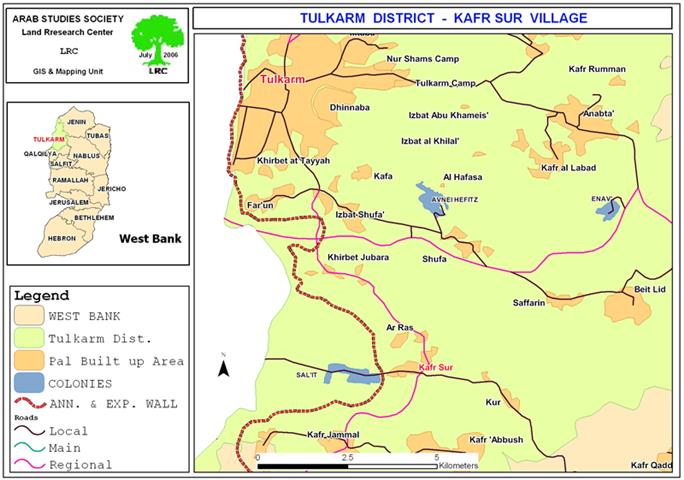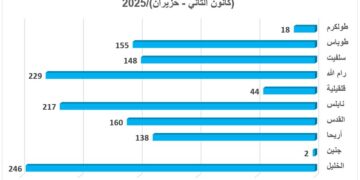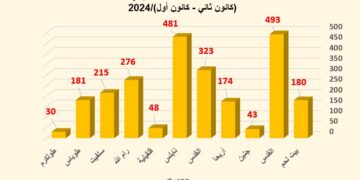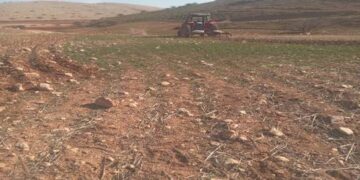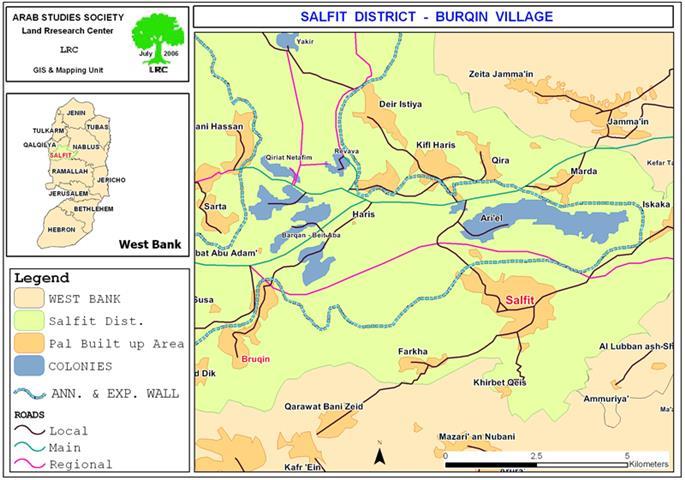The Israeli settlers from the settlement of Sal�it (located on the Green Line west of the village of Kafr Sur in Tulkarem governorate) took advantage of the presence of the Annexation and Expansion Wall in that region and the fact that Palestinian farmers cannot reach their lands and started a plowing operation for the past two weeks in the western direction of the settlement, an area called Waqf Al Urdon. The plowing, taking place on a land that is owned by the heirs of Mr. Omar Ahmad Hamza, aims at establishing a 150-meter long road with a width of 20 meters as a preliminary step to enlarge the settlement. Moreover, settlers have also plowed more lands in the southeastern direction of the settlement destroying in the process tens of olive trees.
It is worth noting that the settlement of Sal�iet was established in 1977. Its population as of 2004 was about 443. Its build-up area is 256 dunums while its municipal boundaries encompass 1377 dunums (Source: Foundation for Middle East Peace).
Kafr Surr Background
The village is located in the southern side of the Governorate of Tulkarem and about 12 kilometers away from the city. The village is situated close to the Green Line. According to the latest statistics, the population of the village is around 1200 Palestinians most of whom depend on agriculture and shepherding as the main source of income. The remaining part of the population depends on public and private employment as a source of income.
The total area of the village is about 9274 dunums, 419 dunums of which constitute its built up. An additional 5000 dunums are planted with Roman olive trees while 1350 dunums are included within the boundaries of the settlement of Sal�it in the western side of the village. The remaining dunums are used for shepherding purposes.
Aggressive Settlement Campaign
The village of Kafr Sur, along with other Palestinian villages in the vicinity of the Green Line, has been subjected to an intense settlement campaign as a result of the establishment of the Israeli Expansion and Annexation Wall on the lands of the village in 2003. The length of the Wall is 1 kilometer with a width ranging between 50 -70 meters which led to the isolation of about 4,000 dunums behind it. The occupation forces established only one gate (carrying the number 839) in the Wall which opens three times a day according to the mood of the soldiers manning it. The gates opens up for 45 minutes each time, yet it was reported that sometimes soldiers keep it shut or they are late in opening it for the Palestinians. According to the Palestinian Liaison Office, the gate opens between 5:00 AM and 5:45 AM, 1:00 PM to 1:45 PM and between 4:00 PM and 4:45 PM.

Photo 1: A view of the Wall with the settlement of Sal'it in the background
Israeli authorities have been slacking in issuing permits for Palestinian farmers to reach their lands located behind the Wall through the afore-mentioned gate. These authorities have issued a mere 120 permits out of the 198 applications submitted to them. As usual, these authorities said that the rejection of some applications was based on �security reasons.� Yet, the reality is that Israeli occupation authorities aim at cutting off the ties between the farmer and his land as to confiscate it with a relative ease.


Photo 2 & Photo 3: parts of the land separated behind the Wall to the west of Kafr Sur)
Legal Procedures
It is worth noting here that the Israeli occupation authorities did not distribute any official warning vis-Ã -vis the plowing process mentioned above. An official complaint was filed with the Israeli High Court via one of the Palestinian human rights organizations and its lawyer Mr. Azem Bishara. The Court did not discuss the complaint as of yet.

Photo 4: another section of the Wall built on the land of Kafr Sur
Prepared by
The Land Research Center
LRC


